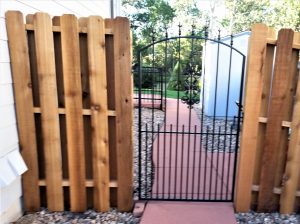All Categories
Featured

As sustainability ends up being a top priority for house owners and services alike, the need for environmentally friendly products, including secure fencing products, has actually climbed. Typical secure fencing options such as timber, metal, and plastic can have negative ecological influences, but there are currently several eco-conscious alternatives to think about. Selecting environment-friendly fence materials not only helps in reducing your carbon impact yet likewise adds to a much more natural and lasting atmosphere.
- Bamboo Fencing. Bamboo is one of the most green fence alternatives offered. Unlike typical woods, bamboo can be collected in a few years and grows back swiftly, making it a sustainable option for fence.
Conveniences: Bamboo is fast-growing, lightweight, and lasting. It needs less chemicals and fertilizers contrasted to other plants, making it a low-maintenance alternative. Considerations: While bamboo is long lasting, it may require routine maintenance to shield it from weathering and all-natural wear. It can also be at risk to fracturing in chillier climates. 2. Recycled Materials. Fences made from recycled products are ending up being progressively prominent as a green alternative. These fences are made from post-consumer plastic, recovered wood, and other recycled materials, maintaining waste out of garbage dumps. Using recycled products minimizes the demand for brand-new raw resources, reducing environmental deterioration.

Benefits: These fences assist minimize waste and conserve all-natural resources. They are likewise usually low-maintenance and resilient. Considerations: While recycled fencings can be sturdy, the aesthetics may not constantly match typical secure fencing choices. Nevertheless, many styles are now offered that resemble the look of wood or rock. 3. Composite Secure fencing. Compound secure fencing is made from a mixture of recycled wood fibers and plastic, offering the look of wood without the ecological effect. Numerous composite fencings are made from recycled content, more improving their environment-friendly status. These fencings are long-lasting, require marginal maintenance, and do not need to be treated with harmful chemicals like traditional wood fencings.
Advantages: Composite fences are sturdy, resistant to rot, and need little maintenance. They additionally supply a comparable aesthetic to timber without deforestation worries. Factors to consider: While they are low-maintenance, composite fences might be much more pricey than typical wood or plastic alternatives. The production procedure can likewise be energy-intensive. 4. Cedar and Redwood Fence. Cedar and redwood are natural timber products that are often taken into consideration extra green compared to various other hardwoods. These kinds of timber are naturally resistant to decay, pests, and moisture, which lowers the demand for chemical therapies. Additionally, these trees are expanded in lasting woodlands, making certain that they are gathered responsibly.
Perks: Cedar and redwood are both long lasting and naturally beautiful materials. They provide all-natural resistance to insects and rot, which helps in reducing the demand for chemical treatments. Considerations: These woods can be much more expensive than other choices. They also call for periodic maintenance, such as sealing or tarnishing, to make certain durability. 5. Living Fences (Hedges and Hedges) Living fencings, made from bushes, trees, or hedges, are an environmentally friendly option that likewise provides all-natural personal privacy and aesthetic appeal. Plants such as privet, boxwood, bamboo, and arborvitae are typically utilized for creating dense, eco-friendly fences. These living barriers assist with noise reduction, improve air top quality, and provide habitat for regional wild animals.
Advantages: Living fences promote biodiversity, improve air top quality, and improve the visual allure of your home. They also absorb carbon dioxide and add to a greener environment. Factors to consider: Living fences require upkeep, such as trimming and watering, to guarantee they grow correctly. They might not offer the very same degree of security as typical fence materials. 6. Rock and Reclaimed Brick Fencing. Rock and recovered block fencings are an additional environment-friendly alternative. These materials are long lasting, need marginal upkeep, and have a long life expectancy. When recovered from old buildings or structures, they help lower the demand for new products and protect against waste from going into garbage dumps.
Perks: Stone and brick are resilient, weather-resistant, and supply an ageless, classic aesthetic. Reclaimed materials additionally have a marginal ecological footprint. Considerations: The installation of rock and brick fences can be labor-intensive, and the materials may be extra costly than other choices. The long-term sturdiness and low upkeep costs can make them a rewarding financial investment. Verdict. Picking an environment-friendly fence product is a wise method to minimize your environmental influence while enhancing your home's privacy and aesthetic appeal. Bamboo, recycled materials, composite fence, and living fences all provide sustainable choices that reduce waste, conserve resources, and advertise a greener way of life.
By selecting among these environmentally friendly secure fencing options, you add to the defense of the setting while creating a lovely, useful outdoor area. The ideal material will depend upon your choices, climate, and the degree of upkeep you're willing to provide, but felt confident that there are various eco-conscious choices that straighten with your lasting way of living.
Latest Posts
Stylish Convenience Starts from the Ground Up
Published Apr 20, 25
1 min read
Discovering the Conveniences of WyHy Share Interest-bearing Account
Published Apr 20, 25
1 min read
A Retro Eating Experience at Gasoline Allie's.
Published Apr 20, 25
2 min read